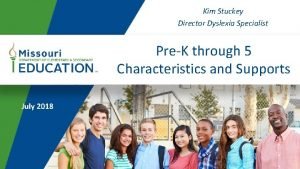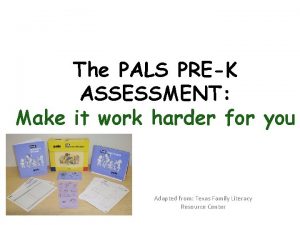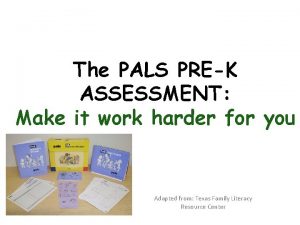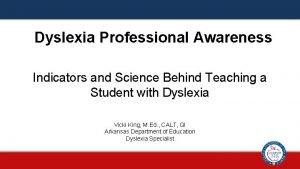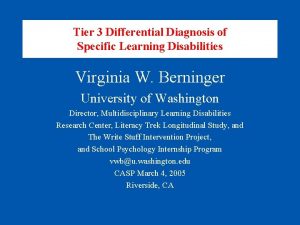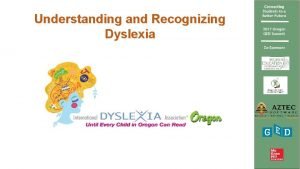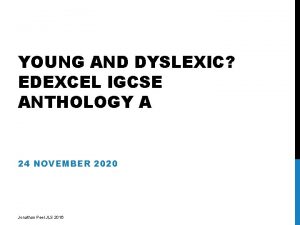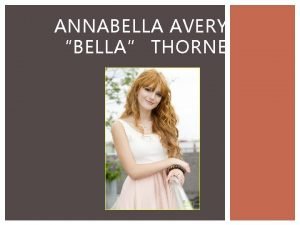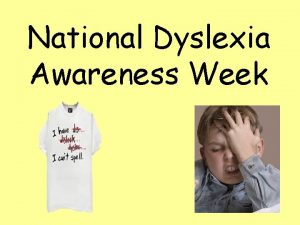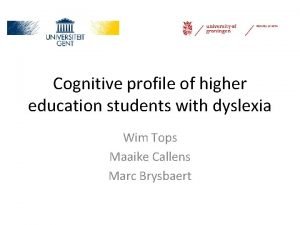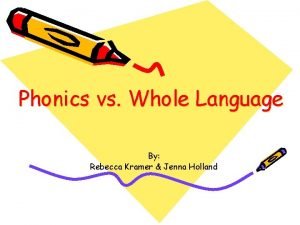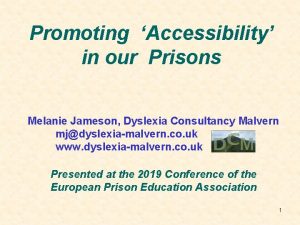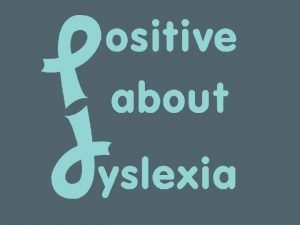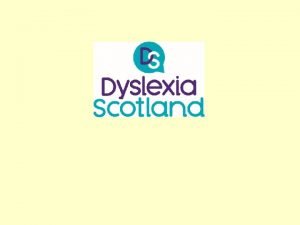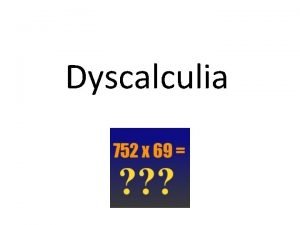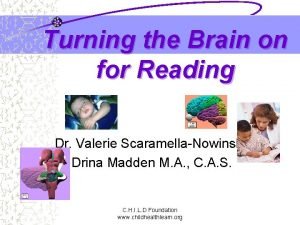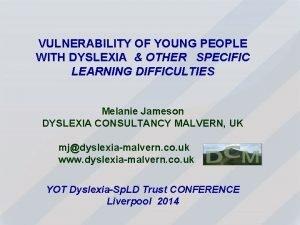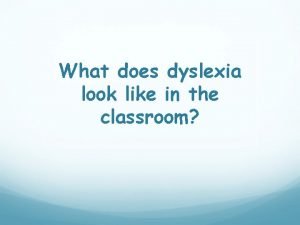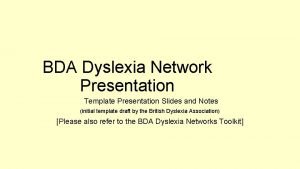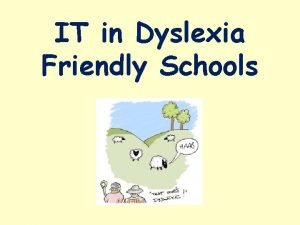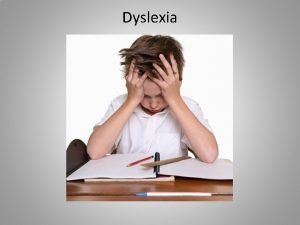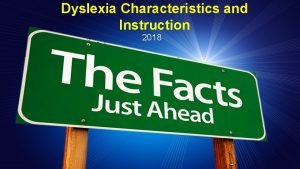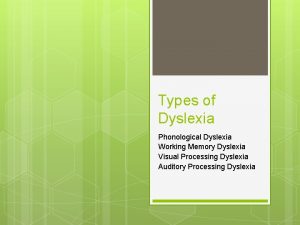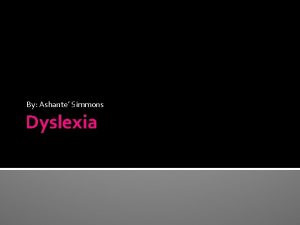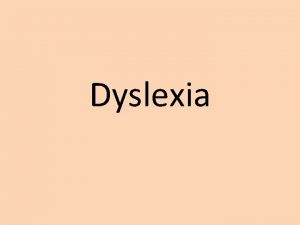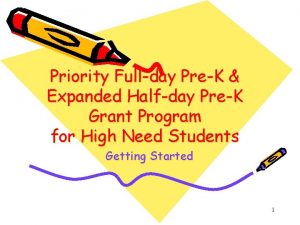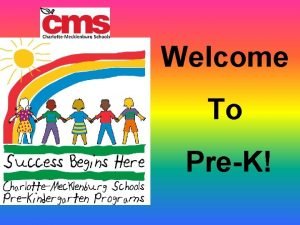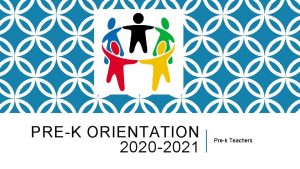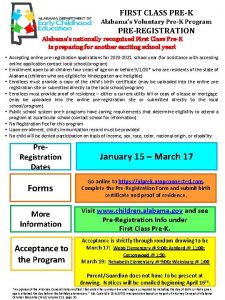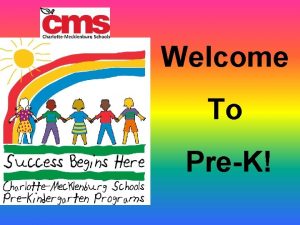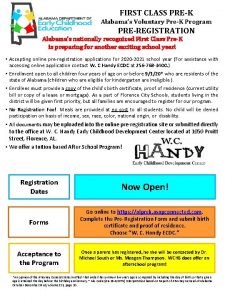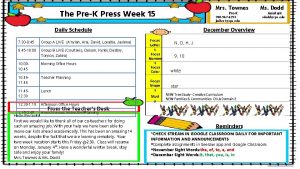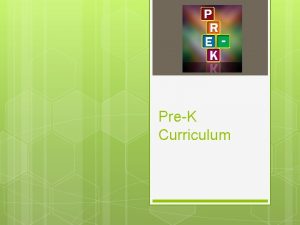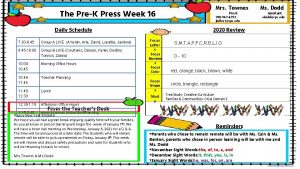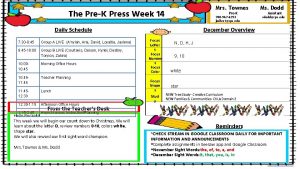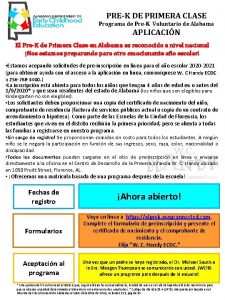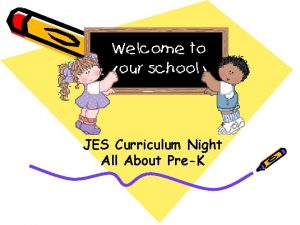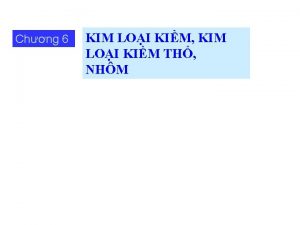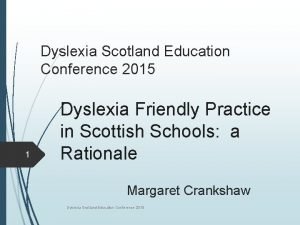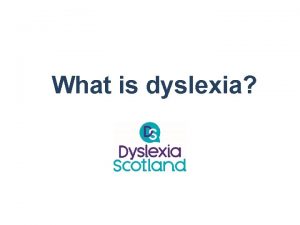Kim Stuckey Director Dyslexia Specialist PreK through 5
























- Slides: 24

Kim Stuckey Director Dyslexia Specialist Pre-K through 5 Characteristics and Supports July 2018

What we’ll cover today § Common characteristics of dyslexia § Consider possible supports and accommodations

Definition • neurobiological in origin • characterized by difficulties with accurate and/or fluent word recognition and by poor spelling and decoding abilities • difficulties typically result from a deficit in the phonological component of language • difficulties often unexpected in relation to other cognitive abilities and the provision of effective classroom instruction • secondary consequences may include problems in reading comprehension and reduced reading experience that can impede growth of vocabulary and background knowledge. IDA/NICHD, 2002


Pre-K and Kindergarten § § § Delayed speech Mixing up sounds and syllables Late establishing a dominant hand Trouble learning letter, colors, numbers Difficulty seeing patterns in words

§ Unable to recognize letters in own name § Difficulty attaching labels to objects § Trouble following directions or sequencing § Telling time, tying shoes § Confusion with directionality § Poor Spelling

Grades 1 -2 § § § Difficulty learning a new word even after multiple teachings Word Retrieval Trouble memorizing Handwriting Written Expression

Reading Aloud § § § § Guesses based on shape (house/horse, breakfast/basket) Correct sounds, incorrect sequence (from/form, stop/spot, was/saw, who/how, lots/lost) may use semantic substitution (speed/fast, puppy/dog) Inserts or omits sounds (could/cold, stream/steam) Skips or misreads prepositions Ignores suffixes (even/evening, come/coming) Confuses vowel sounds (bat/bet/bit)

§ And may confuse similarly shaped letters beyond second grade

Grades 3 -5 (same as previous plus. . ) § Difficulty with sight words § Relies heavily on auditory information § Cannot retain spelling words beyond the weekly test § Avoids reading or becomes frustrated easily § Takes inordinate amount of time to complete written assignments or test

§ § § Seems brighter than written work produced Effort not commensurate with grades Written vs. oral word choice Poor recall for testing Difficulty with retelling, details within stories or events retrieved from Understood. org

12 Supports and Accommodations

13 General Environment Click to enter Content Technology Social

General § § § § Extended time Repeated review Teacher provided notes Reduce copying Models, Scaffolding, Chunking Graphic organizers, Test format Oral and printed directions Planners or organizers

Environment § Maintain routine § Structured time for organizing or transitioning § Visual supports for spelling, letters, number, math § Avoid round robin reading unless volunteers § Opportunities for response that support memory challenges

Technology § § § Tools Training for student, teacher and parent Allow for type written work Access to digital resources Audio supports

Social Emotional § § Gauge frustration Provide opportunities to demonstrate mastery Positive feedback Acknowledge effort and process as well as outcome § Focus on student strengths

Content Considerations § Math § Calculator § Order of operations § Reading support § Science/Social Studies § Names and dates § Processes and Vocabulary


We welcome your feedback https: //www. surveymonkey. com/r/OCCREvaluation

Resources • • • Bowers, Peter, How the Written Word Works, 2010 Henry, Marcia, Unlocking Literacy, 2 nd Ed. , 2010 Moats, Louisa Cook, Speech to Print, 2 nd Ed. , 2010 Kilpatrick, David, Equipped for Reading Success, 2016 Kilpatrick, David, Essentials of Assessing, Preventing and Overcoming Reading Difficulties, 2015 • Selznick, Richard, Dyslexia Screening, 2015

Online § § § § Florida Center http: //fcrr. org NCIL http: //improvingliteracy. org IDA http: //eida. org Reading Rockets http: //readingrockets. org Understood http: //understood. org NCII http: //intensiveintervention. org CERI http: //effectivereading. org

Contact Kim Stuckey kim. stuckey@dese. mo. gov 573 -751 -2584 Edmodo Group Code: fsj 36 g

 Kim stuckey
Kim stuckey Mondays chils
Mondays chils Agribino
Agribino Pals reading assessment
Pals reading assessment Prek newsletter
Prek newsletter Pals-prek assessment pdf
Pals-prek assessment pdf Dyslexia definition
Dyslexia definition Dyslexia differential diagnosis
Dyslexia differential diagnosis Ida definition of dyslexia
Ida definition of dyslexia Edexcel igcse english language young and dyslexic
Edexcel igcse english language young and dyslexic Bella thorne fansite
Bella thorne fansite Causes of dyslexia
Causes of dyslexia Dyslexia cognitive profile
Dyslexia cognitive profile Dyslexia
Dyslexia Dyslexia assessment malvern
Dyslexia assessment malvern Dyslexia
Dyslexia How many people have dyslexia
How many people have dyslexia Mildly dyslexic
Mildly dyslexic Prevelance of dyslexia
Prevelance of dyslexia Dyseidetic dyslexia
Dyseidetic dyslexia Dyslexia vulnerability
Dyslexia vulnerability What does dyslexia look like in the classroom
What does dyslexia look like in the classroom Maharashtra dyslexia association
Maharashtra dyslexia association Bda dyslexia
Bda dyslexia Dyslexia
Dyslexia
